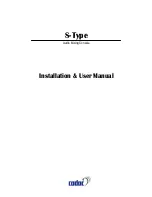
The high current outputs will give about 15.5 to 18.5V into a load of 1k
Ω
.
The output voltage may fall by up to 1 volt when the load resistance is reduced to
20
Ω
.
12.15.5
Mechanical
The unit is assembled on a plug-in board which is housed in the Main Power
Unit case.
12.16 Amplifier Type Q
12.16.1
Purpose
This amplifier receives its input from the nominal zero level cue line output,
intercom, or alternative talkback output and will deliver up to 0.5 watt into a load of
8
Ω
. For cueing this will normally be fed to headphones. With headphones of
normal sensitivity, a very loud signal can be produced into 6 pairs of 50
Ω
headphones in parallel. For other purposes a reasonably loud signal can be
produced from an 8
Ω
loudspeaker.
12.16.2
Circuit
The circuit diagram is shown on Drawing No. BE218.
12.16.3
Circuit Description
VT1 acts as an input amplifier stage which feeds current through coupling
capacitor C3 to the virtual earth input of the main part of the amplifier. Since this
amplifier is not in a main signal channel of the Mixer, the time constant C1 R2 is
less than normally used and therefore gives a small bass roll-off.
VT5 and VT6 are power transistors of the same type arranged as a
transformerless class AB push pull output stage. VT5 is driven by an emitter
follower VT3 (n p n). VT6 is driven by VT4 (p n p) with 100% feedback from the
collector of VT6 to the emitter of VT4. The bases of VT3 and VT4 are dirven from
the collector of VT2. R10, R11, R12, and R13 are 2
Ω
high dissipation resistors
connected in the emitter and collector circuits of VT5 and VT6 for peak current
equalization and limitation.
Feedback is taken from the output (prior to the output coupling capacitor C9)
through R14 and R15 in series to the virtual earth input. It will be seen that VT2 and
VT6 are fully d.c. coupled both in the forward and in the feedback directions.
D1 and D2 are included to assist thermal stability. AOT 1 is selected on test
to give the correct quiescent current in the output stage which is 0.5 mA at ambient
temperatures between 15
°
C and 20
°
C. The value must by varied by
±
1.5mA for
temperature ranges of
±
5
°
respectively outside these limits.
A ferrite bead L1, capacitors C4, C5, C6, C8 and the combination R17, C10
are all included for the prevention of r.f. oscillation.
The heavy current +17V supply and the output each have two contacts in
parallel on the plug and socket connector whilst the heavy current 0V line has three
contacts and on the board this line is kept separate from the remainder of the 0V
line, the two parts being connected together at the socket.
















































